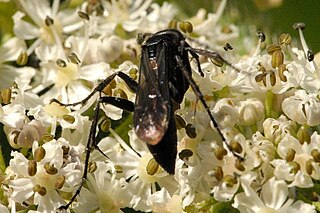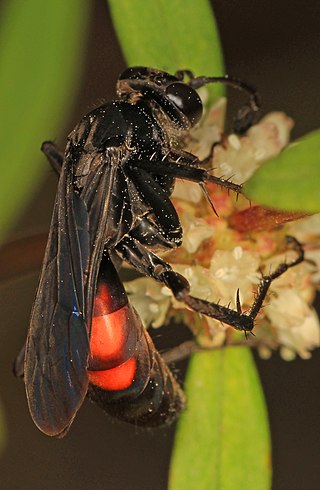
Anoplius is a genus of spider wasps in the family Pompilidae, called the blue-black spider wasps.

Anoplius nigerrimus is one of the most common spider wasps, or pompilids, in Europe. They are mostly black and the females are 6–8 mm long while males measure 5–8 mm. This species may be distinguished from the related Anoplius concinnus and Anoplius caviventris by the 20 setae, or hairs, on the forehead rather than 60 or 45.

Anoplius viaticus, commonly known as the black-banded spider wasp, is a species of spider wasp. These wasps are known as spider wasps because the females capture spiders to provide their offspring with food. The paralysed spider is cached in a burrow, the wasp lays an egg on it, and when this hatches, the developing wasp larva consumes the spider. This species is found in sandy heathland across most of Europe.

Anoplius americanus is a species of blue-black spider wasp which is widely distributed in the New World.
Notiodes is a genus of marsh weevils in the beetle family Erirhinidae. There are about 16 described species in Notiodes.
Anoplius virginiensis is a species of spider wasp in the family Pompilidae.
Anoplius illinoensis is a species of spider wasp in the family Pompilidae.
Nisoscolopocerus apiculatus is a species of leaf-footed bug in the family Coreidae. It is found in North America.
Nisoscolopocerus is a genus of leaf-footed bugs in the family Coreidae. There are at least two described species in Nisoscolopocerus.
Rhynchus is a genus of hidden snout weevils in the family of beetles known as Curculionidae. There is at least one described species in Rhynchus, R. apiculatus.
Anoplius subcylindricus is a species of spider wasp in the family Pompilidae.
Anoplius cleora is a species of spider wasp in the family Pompilidae.

Anoplius aethiops is a species of spider wasp in the family Pompilidae. It primarily lives in overgrown fields with fine-grained soil. It provisions its young with paralyzed Lycosidae spiders, especially those of the genus Hogna.

Anoplius atrox is a species of spider wasp in the family Pompilidae.
Anoplius carolinus is a species of spider wasp in the family Pompilidae.

Anoplius semirufus is a species of spider wasp in the family Pompilidae.
Anoplius ithaca is a species of spider wasp in the family Pompilidae.

Anoplius depressipes is a species of spider wasp in the family Pompilidae. It is a known predator of fishing spiders from the genus Dolomedes, and the wasp is highly adept at walking on the surface of water.

Ceropales bipunctata, the Two-Speckled Cuckoo Spider Wasp, is a species of diurnal, kleptoparasitic spider wasp in the family Pompilidae. It is an obligate kleptoparasite, meaning that it must rely on the captured provisions of other spider wasps and cannot capture its own. It is found on the Atlantic Coast of North America, north to New Brunswick, Canada. It feeds on nectar primarily from goldenrods, and also other common nectaring plants. It is known to lay an egg on the prey of other pompilids, including the two species Anoplius cleora and Anoplius aethiops. Eggs are laid in the book lung of the spider. These wasps also sometimes lay an egg on prey from spider-hunting wasps in the family Sphecidae.

Leucopogon apiculatus is a species of flowering plant in the family Ericaceae and is endemic to the south of Western Australia. It is an erect shrub with oblong to elliptic leaves and pink to white tube-shaped flowers.










